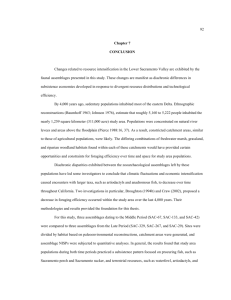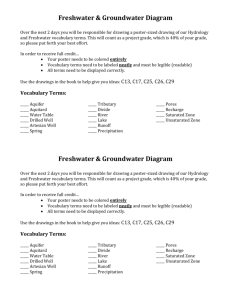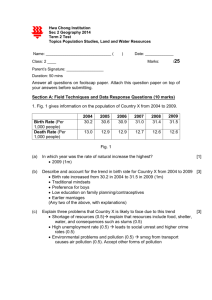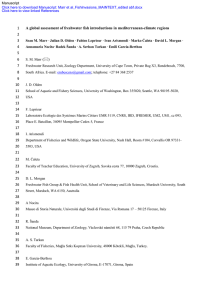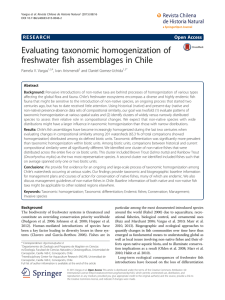A global assessment of freshwater fish introductions in
advertisement
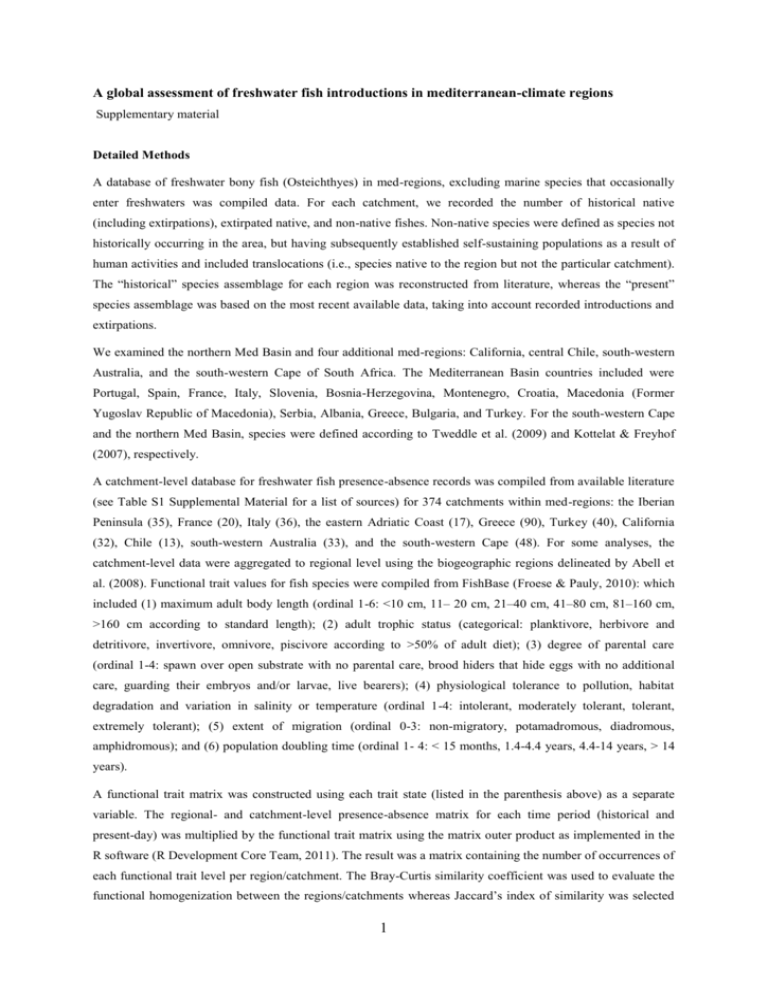
A global assessment of freshwater fish introductions in mediterranean-climate regions Supplementary material Detailed Methods A database of freshwater bony fish (Osteichthyes) in med-regions, excluding marine species that occasionally enter freshwaters was compiled data. For each catchment, we recorded the number of historical native (including extirpations), extirpated native, and non-native fishes. Non-native species were defined as species not historically occurring in the area, but having subsequently established self-sustaining populations as a result of human activities and included translocations (i.e., species native to the region but not the particular catchment). The “historical” species assemblage for each region was reconstructed from literature, whereas the “present” species assemblage was based on the most recent available data, taking into account recorded introductions and extirpations. We examined the northern Med Basin and four additional med-regions: California, central Chile, south-western Australia, and the south-western Cape of South Africa. The Mediterranean Basin countries included were Portugal, Spain, France, Italy, Slovenia, Bosnia-Herzegovina, Montenegro, Croatia, Macedonia (Former Yugoslav Republic of Macedonia), Serbia, Albania, Greece, Bulgaria, and Turkey. For the south-western Cape and the northern Med Basin, species were defined according to Tweddle et al. (2009) and Kottelat & Freyhof (2007), respectively. A catchment-level database for freshwater fish presence-absence records was compiled from available literature (see Table S1 Supplemental Material for a list of sources) for 374 catchments within med-regions: the Iberian Peninsula (35), France (20), Italy (36), the eastern Adriatic Coast (17), Greece (90), Turkey (40), California (32), Chile (13), south-western Australia (33), and the south-western Cape (48). For some analyses, the catchment-level data were aggregated to regional level using the biogeographic regions delineated by Abell et al. (2008). Functional trait values for fish species were compiled from FishBase (Froese & Pauly, 2010): which included (1) maximum adult body length (ordinal 1-6: <10 cm, 11– 20 cm, 21–40 cm, 41–80 cm, 81–160 cm, >160 cm according to standard length); (2) adult trophic status (categorical: planktivore, herbivore and detritivore, invertivore, omnivore, piscivore according to >50% of adult diet); (3) degree of parental care (ordinal 1-4: spawn over open substrate with no parental care, brood hiders that hide eggs with no additional care, guarding their embryos and/or larvae, live bearers); (4) physiological tolerance to pollution, habitat degradation and variation in salinity or temperature (ordinal 1-4: intolerant, moderately tolerant, tolerant, extremely tolerant); (5) extent of migration (ordinal 0-3: non-migratory, potamadromous, diadromous, amphidromous); and (6) population doubling time (ordinal 1- 4: < 15 months, 1.4-4.4 years, 4.4-14 years, > 14 years). A functional trait matrix was constructed using each trait state (listed in the parenthesis above) as a separate variable. The regional- and catchment-level presence-absence matrix for each time period (historical and present-day) was multiplied by the functional trait matrix using the matrix outer product as implemented in the R software (R Development Core Team, 2011). The result was a matrix containing the number of occurrences of each functional trait level per region/catchment. The Bray-Curtis similarity coefficient was used to evaluate the functional homogenization between the regions/catchments whereas Jaccard’s index of similarity was selected 1 for the taxonomic data because it is the most commonly used index in taxonomic homogenization studies (Olden & Rooney, 2006). Compositional similarity (CS) for the historical assemblages (CS H) and present-day assemblages (CS P), both from taxonomic and functional data, were calculated separately for each time period using the “vegdist” function of the “vegan” package (Oksanen et al., 2010) in R. Taxonomic (TH) and functional homogenization (FH) were quantified as the change in CS index (ΔCS) for each pair of regions/catchments; calculated as ΔCS = CS P – CS H (Olden & Rooney, 2006). The regional/catchment CS H and ΔCS were calculated as the average pairwise CS H and ΔCS values. In addition, the compositional similarity between the historical and present-day fish assemblages was calculated for each region/catchment to confirm the level of change in compositional similarity. Non-metric multi-dimensional scaling (N-MDS) was performed to summarise multivariate patterns in taxonomic and functional composition among the regions using the PRIMER-E 6.1.5 statistical software package (Clarke & Warwick, 2001). The change in compositional similarity between the historical and presentday assemblages was evaluated using permutational multivariate analysis of variance (PERMANOVA) and a permutation test of multivariate homogeneity of groups dispersions (PERMDIST), as implemented in the PRIMER-E software (Anderson, 2001; Anderson et al., 2008). Table S2: Traits of the fish species considered to test for functional homogenization. Variable Categories Adult trophic status Assigned according to the main food items (>50% of adult diet): 1 planktivore; 2 – herbivore and detritivore; 3 - invertivore; 4 - omnivore; 5 - piscivore. Degree of parental care 1 - spawn over open substrate with no parental care; 2 - brood hiders, hiding eggs with no additional care; 3 - guarders, guarding their embryos and/or larvae; 4 - bearers, carry their embryos with them. Population time doubling 1 - < 15 months; 2 – 1.4-4.4 years; 3 – 4.4-14 years; 4 – > 14 years. Maximum adult size 1 - < 10 cm; 2 - 11– 20 cm; 3 - 21–40 cm; 4 - 41–80 cm; 5 - 81–160 cm; 6 - >160 cm of standard length Physiological tolerance Physiological tolerance of the species to pollution, habitat degradation and variation in salinity or temperature. 1 - intolerant fishes; 2 moderately tolerant fishes; 3 - tolerant fishes; 4 - extremely tolerant fishes Extent of migration 0 – non-migratory, 1 - potamadromous, 2 - diadromous, 3 – amphidromous 2 References Abell, R., M. L. Theime, C. Revenga, M. Bryer, M. Kottelat, N. Bogutskaya, B. Coad, N. Mandrak, S. Contreras-Balderas, W. Bussing, M. L. J. Stiassny, P. Skelton, G. R. Allen, P. Unmack, A. Naseka, R. Ng, N. Sindorf, J. Robertson, E. Armijo, J. V. Higgins, T. J. Heibel, E. Wikramanayake, D. Olson, H. L. Lopez, R. E. Reis, J. G. Lundberg, M. H. Sabaj Perez & P. Petry, 2008. Freshwater Ecoregions of the world: a new map of biogeographic units for freshwater biodiversity conservation. BioScience 58:403-414. Anderson, M. J., 2001. Permutation tests for univariate or multivariate analysis of variance and regression. Canadian Journal of Fisheries and Aquatic Sciences 58:626-639. Anderson, M. J., R. N. Gorley & K. R. Clarke, 2008. PERMANOVA+ for PRIMER: Guide to Software and Statistical Methods. PRIMER-E: Plymouth Marine Laboratory, Plymouth, UK. Clarke, K. R. & R. M. Warwick, 2001. Change in Marine Communities: An Approach to Statistical Analysis and Interpretation, 2nd edition. PRIMER-E: Plymouth Marine Laboratory, Plymouth, UK. Froese, R. & D. Pauly (eds), 2010. FishBase 2010: concepts, design and data sources. International Center for Living Aquatic Resource Management, Manila. www.fishbase.org. Kottelat, M. & J. Freyhof, 2007. Handbook of European Freshwater Fishes. Kottelat and Freyhof, Cornol, Switzerland and Berlin, Germany. Oksanen, J., F. G. Blanchet, R. Kindt, P. Legendre, R. B. O’Hara, G. L. Simpson, P. Solymos, M. H. H. Stevens & H. Wagner, 2010. VEGAN: Community Ecology Package version 1.17-4. http://R-Forge.Rproject.org/projects/vegan/. Olden, J. D. & T. P. Rooney, 2006. On defining and quantifying biotic homogenization. Global Ecology and Biogeography 15:113-120. R Development Core Team, 2011. R: A Language and Environment for Statistical Computing. R Foundation for Statistical Computing, Vienna, Austria, http://www.R-project.org. Tweddle, D., R. Bills, E. Swartz, W. Coetzer, L. Da Costa, J. Engelbrecht, J. Cambray, B. Marshall, D. Impson, P. Skelton, W. R. T. Darwall & K. G. Smith, 2009. The status and distribution of freshwater fishes. In Darwall, W. R. T., K. G. Smith, D. Tweddle & P. Skelton (eds), The status and distribution of freshwater biodiversity in Southern Africa. Gland, Switzerland: IUCN and Grahamstown, South Africa: South African Iinstitute for Aquatic Biodiversity, 21-37. 3



